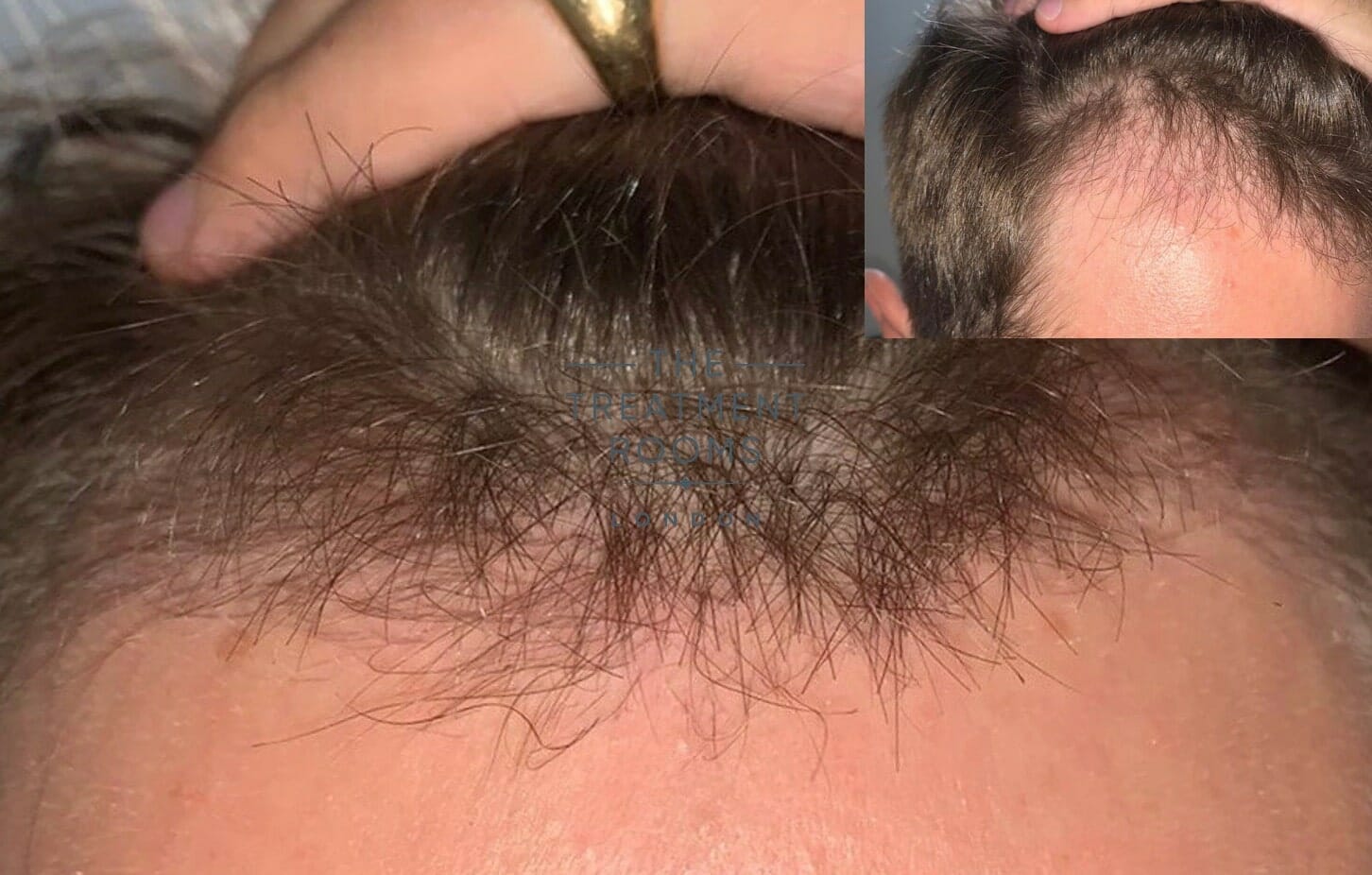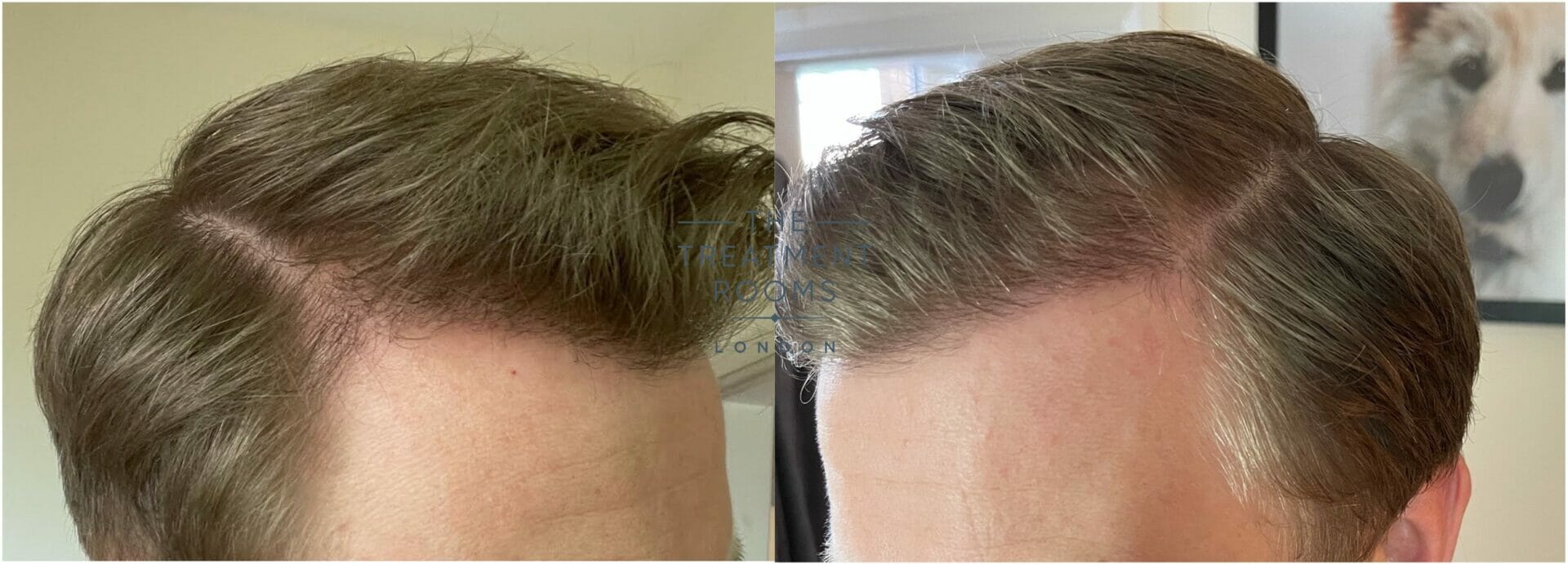What To Expect From Your Hair Transplant After 6 Months
Having a hair transplant can be exciting, and you may be impatient as you wait for your newly transplanted locks to grow.
The 6-month mark after your hair transplant is a significant milestone in your recovery. At this point, you may notice visible regrowth as your new follicles emerge and thicken.
In this blog post, we will discuss what happens in the first 6 months, what hair growth you can expect after 6 months and any challenges you might face. Learn everything you need to know here with The Treatment Rooms London.
6 months after a hair transplant is a point at which many of our patients start to see some meaningful hair growth. A very small number of patients may not have started growing at this point and that might be normal for them too. We reassess all patients at the 11 or 12 months mark following their hair transplant
Dr Roshan Vara, Hair Transplant Surgeon
What happens during the first 6 months?
At The Treatment Rooms London, we offer a follicular unit excision (FUE) hair transplant. During an FUE, the surgeon removes individual hair follicles from your scalp and transplants them into your areas of concern. An FUE is minimally invasive and can provide faster recovery and natural-looking results.
As soon as your hair transplant is complete, your journey to recovery begins. The process of healing should be straightforward, but you must follow the aftercare advice we give you to get the best results.
Immediately after your hair transplant
After your completed transplant, you may experience swelling and tenderness in the donor areas. The after-effects usually subside within a few days and simple pain relief medications like ibuprofen or paracetamol may help. You will also notice some scabs or a crust begin to form around the newly transplanted follicles, which is completely normal — these will fall off within 1-2 weeks.
You must keep your scalp protected while it’s healing so you do not disturb the transplanted hair. So, no washing, rubbing, drying or scrubbing of any kind for the first 4 days post-surgery. You must also protect your scalp from the sun, so try your best to avoid it at peak times and protect your scalp with a cap.
First 2 weeks after your hair transplant
Within the first two weeks of your recovery, some of your transplanted hairs will shed. While this may seem alarming or a sign that your hair transplant hasn’t worked, it is normal and new hairs should regrow in the areas within a few weeks.
2–3 months after your hair transplant
In the following couple of months, your hair might enter a resting phase where it doesn’t grow as much or as fast as usual. This phase occurs as the new hair follicles establish themselves in your scalp. You might not see many changes to your hair at this point.

3–6 months after your hair transplant
By this time, your hair should have entered the growth phase again and your newly transplanted follicles will begin to show noticeable signs of growth. However, it can take a little while longer for your hair to thicken and any transplanted patches to become full again.

Hair growth progress after 6 months
Once you are 6 months post-hair transplant, you should see a visible change in the thickness and length of your hair. The new follicles will also be much stronger.
When you compare your hair density to what it was like before you had your transplant and at the beginning of your recovery to your 6-month results, most patients should notice a difference.
It is worth bearing in mind that the new hair growth might not be consistent, with some regions being slightly longer or denser than others. This is a normal part of the process and why it’s important to wait up to 18 months before deciding whether you’re happy with the results.
If you have uneven growth or the regrowth results in a hairline you don’t love, you can always get your haircut. It might be beneficial to keep it slightly shorter so that the regrowth doesn’t show as much. This also means the transplanted follicles don’t have as much catching up to do with the rest of your hair.
However, while the six-month mark is a significant milestone in your hair regrowth journey, it’s not the final result. It can take 12–18 months for the final results to appear. By then, the transplanted follicles will have fully penetrated the scalp and matured — making them as thick and pigmented as the rest of your hair.
Factors that influence your hair growth
All sorts of factors can influence your hair regrowth six months after your hair transplant:
- Your age – being older can mean slower hair growth so your transplanted follicles might not grow as fast.
- Genetics – you may have a genetic predisposition to slow hair growth.
- Poor nutrition or health – your hair will struggle to grow if you aren’t getting enough vitamins and minerals that support growth. Similarly, if you have poor overall health, your new follicles may struggle to grow as rapidly as they could. Deficiencies in vitamins and minerals can also cause poor hair growth, so eating many fruits, vegetables and proteins is essential.
- Certain medications – can harm hair growth so you must let the surgeon know of any medication you take beforehand.
- Stress – while it’s not always avoidable, being stressed during your recovery period could interfere with how well your hair grows.
- Scalp health – you must look after your scalp all the time, but it’s especially important when you have a hair transplant. An unhealthy scalp is a terrible environment for your hair to try and grow from.
- Heat exposure – styling or drying your hair with heat is always damaging, but it’s even more so when you have had a hair transplant. Try to limit the amount of heat you use on your hair and always use a heat protectant.
- Dyeing your hair – the chemicals in the dyes can cause a lot of damage to your hair, preventing healthy growth.
Potential challenges and solutions
6 months after your hair transplant, you may face some unexpected challenges. Uneven growth is possible because different areas of your hair can grow at different rates — so, at around the 6-month mark, you may notice it’s thicker or thinner in certain parts.
Some setbacks may occur around this time, such as slow hair growth after excess shedding. The good news is that slow hair growth often remedies itself if it’s not caused by the factors we mentioned above. However, if your hair has shed excessively prior to 6 months post surgery, you might need to speak with your surgeon and consider waiting until the 18 months mark before evaluating your surgical result.
Although hair transplants can help with pattern baldness, they can’t prevent it from happening. So, while your transplant may have thickened up the front and sides of your hair, you may start to develop balding around your crown or another area especially if you are not taking hair loss prevention medication like Finasteride and Minoxidil. If you don’t see any noticeable hair growth at the six-month point, speak with your surgeon so they can check everything is okay.
Promoting hair growth after a hair transplant
Promoting hair growth after a hair transplant is easier than you think. The main thing is to keep your scalp healthy as this creates the optimum environment for your new follicles to grow.
Some top tips for promoting hair growth after a hair transplant include:
- Eating a well-balanced diet
- Protecting your scalp from the sun
- Drinking enough water
- Using gentle products on your hair and scalp
- Washing your hair in lukewarm water
- Avoiding tight hairstyles that cause tension on your scalp
Getting to 6 months post-hair transplant is an exciting part of your hair transplant journey, because you’ll start to really see the results from your procedure.
When you have a hair transplant with The Treatment Rooms London, we will give you a personalised recovery plan that takes your circumstances into account and helps you take good care of your scalp and hair. By following this plan, you’ll get the best long-term results from your transplant and see a noticeable difference by the time you hit the 6-month mark.
If you have any questions about hair loss or hair transplants, contact The Treatment Rooms London and book a consultation with us today.
Sources
Book A Consultation

